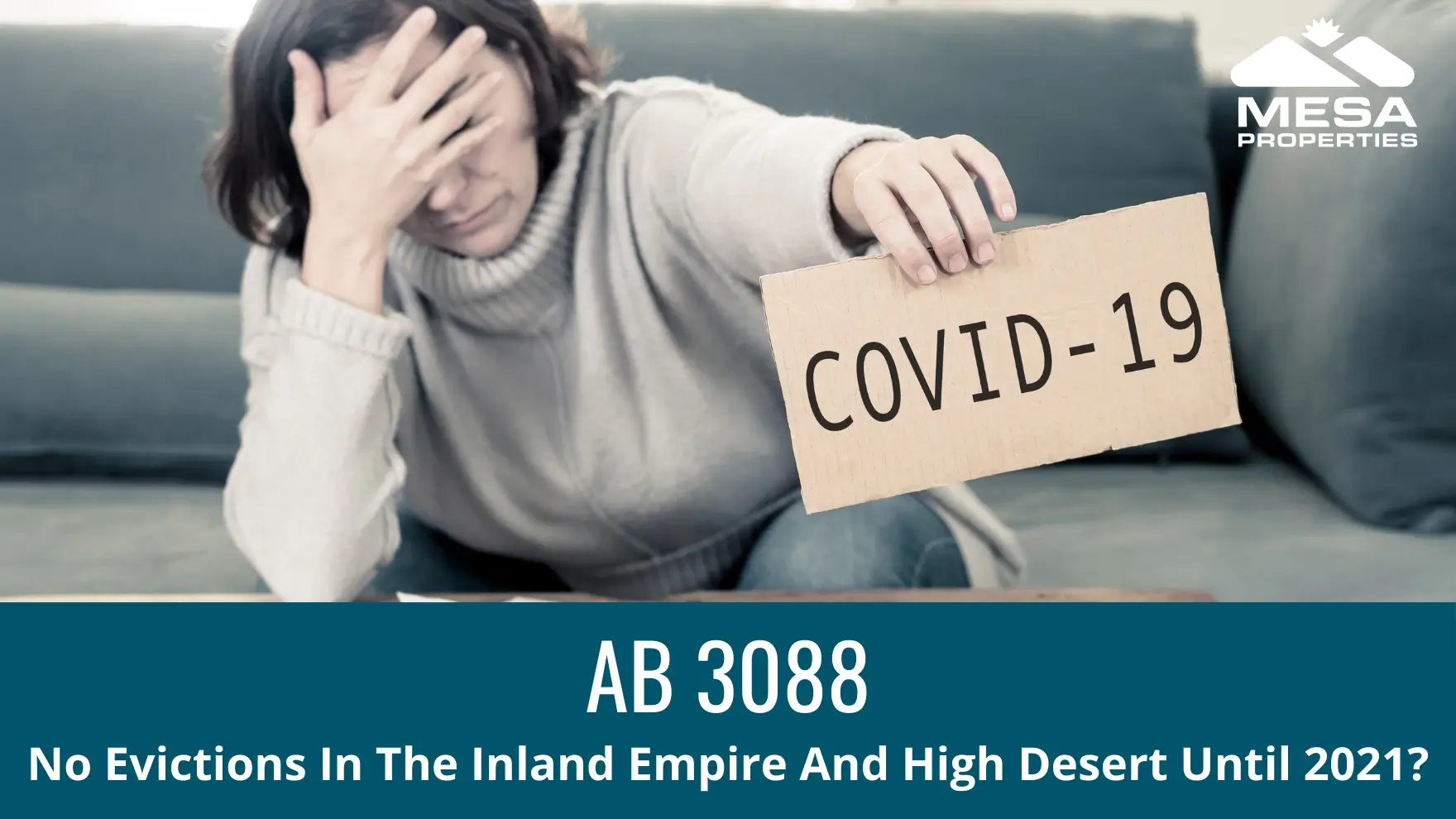Last week we did a video with an update on the state/county/city eviction moratoria and how they affect Inland Empire and High Desert landlords.
We also said that things were changing constantly so that information may be out of date any day now.
Well, here we are 5 days later and just about everything has changed! AB1436 and SB1410 are off the table. They have been replaced by AB3088 which went into effect just before midnight on August 31, 2020.
The Trump Administration via the CDC also announced a nationwide ban on evictions just on Tuesday, September 1, 2020.
There is so much to keep track of, I hope your head isn’t spinning like it feels like mine is. We took the time to read both of these new orders in their entirety and will do our best to sum them up in this video and blog post.
Nothing in this blog post or video is intended to be taken as legal advice. We are not a law firm or licensed attorneys. We receive and interpret these laws directly from the State or Federal government. We have also referenced other material from real estate attorneys that summarizes these new orders.
AB3088
This law was passed before the nationwide eviction moratorium and is specific to the State of California only. The chapter in AB3088 we will focus on is Chapter 5 which has been dubbed the COVID-19 Tenant Relief Act of 2020.
How does this change existing laws?
The 3 day notice to pay rent or quit is now a 15 day notice (not counting weekends and holidays) and must contain specific language from the State of California as well as a declaration of hardship form for the tenant to fill out if they have had their income affected by COVID-19.
So essentially, the 3 day now has three options instead of two: pay, quit or declare COVID hardship.
The “just-cause” eviction rules established in AB1482 from last year are now expanded to ALL tenants in the State of California, regardless of whether the property is exempt from AB1482 or not.
Landlords can be fined $1,000 - $2,500 for violating this law or attempting to evict their tenant through their own means instead of through the court system.
Who does this law cover?
Any tenant who can declare a COVID-19 hardship for the period of March 1, 2020 and January 31, 2021.
What about rent that hasn’t been paid since March?
Landlords need to serve a 15 day notice as discussed earlier. The tenant will then have those 15 days to either pay, quit or declare hardship. If they declare hardship, they can never be evicted for nonpayment of rent from March 1, 2020 - August 31, 2020. The landlord will have to wait until March 1, 2021 to attempt to recover that debt. The rental debt will be converted to consumer debt and the landlord can sue for it in small claims.
The good news here is that the small claims limit is temporarily lifted to allow landlords to go after tenants for more than the standard amount limited in small claims.
What about rent going forward?
Tenants are not completely off the hook for rent going forward. Between September 1, 2020 and January 31, 2021, tenants must pay at least 25% of the rent due for that period by January 31, 2021.
Note: that does not mean the tenant needs to pay 25% of the rent each month it comes due, but must pay 25% of the total due from September 1, 2020 - January 31, 2021 by January 31, 2021 in order to stay protected from eviction under this law.
So in theory, a landlord could go from March 1, 2020 to January 31, 2021 without seeing a dime in rent and no ability to evict their tenant.
Landlords have to wait until March 1, 2021 to attempt to collect the now consumer debt in small claims, just like the requirement for rent that wasn’t paid from March to August.
Does the tenant have to provide proof of hardship?
Only if they make more than 130% of the median income for the area they live in and also make more than $100,000 per year. Anyone else just has to swear under penalty of perjury that they are affected in some way such as lost job, taking off time from work to care for someone who is ill with COVID or unable to work due to no childcare and having to stay home to take care of children.
The tenant does have to provide the declaration of hardship within 15 days (not counting weekends and holidays) of the landlord serving them a notice.
Can landlords evict for other reasons than non-payment of rent?
Nothing in this law appears to prevent this. As long as there is no other local ordinance preventing it, it seems that evictions for other causes such as nuisance should be allowed starting September 2, 2020.
What if my tenant never returns a declaration of hardship?
Evictions should be able to proceed in this case by October 5, 2020.
It’s important to note that this law does say that if the tenant can prove that they had a good reason for not returning the form within 15 days, they can still be protected from eviction.
CDC Nationwide Eviction Moratorium
This one just came out and shocked the landlord community. It covers the entire country from now until December 31, 2020.
In August, President Trump issued an executive order that instructed federal health officials to consider taking action to halt evictions. The CDC has the authority to do this under section 361 of the Public Health Service Act (42 U.S. Code § 264).
The CDC took him up on the recommendation and has issued an order that halts evictions across the country through the end of the year.
The order says that more restrictive state orders take precedence over the federal order. According to Gavin Newsom in a press conference on September 2, 2020, California’s eviction moratorium is more restrictive than the national one, so the national one does not apply.
The CDC is able to do this because they state that temporarily suspending evictions will help stop the spread of COVID-19.
To qualify for protection under this order, a renter must certify five things:
Written certification stating they have made their best effort to use all available government assistance.
Expects to earn less than $99,000/year or $198,000/year if filing jointly, or that they were not required to report income to the IRS in 2019 or that they received a stimulus check.
Written certification that they are unable to pay the full rent due to lost wages or other financial impact form COVID-19.
Must make best effort to at least make partial rent payments.
Must certify that if evicted, they would likely become homeless.
If they can certify this using a form provided by the CDC, they are protected from eviction through the end of the year.
However, they are not relieved of their responsibility to still pay rent and landlords can still charge late fees. The Federal order does not specify how much rent needs to be paid or how unpaid rent will be handled in the coming years.
Summing It Up
Just when you thought it couldn’t get more complicated to be a landlord, we get hit with two new very confusing State and Federal orders in a 24 hour period. It’s worth stating again, this could all change at any time. They can also be extended as past moratoria were.
What will this all mean for landlords? Will there be a wave of foreclosures or will the Federal and State government provide some kind of financial relief to affected landlords?
Much is up in the air and will be determined in the coming weeks. Stay tuned and stay educated. Improperly serving a tenant or attempting to evict when you aren’t allowed to can be a landlord-career ending mistake.



